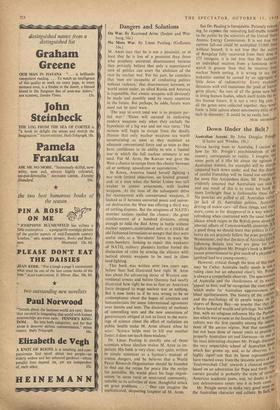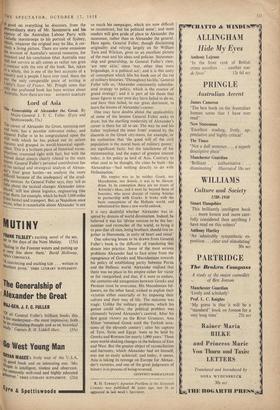Down Under the Belt ?
NEVER having been to Australia, I cannot sal' how far Mr. Pringle's psychoanalysis of that country corresponds to reality. I imagine that some parts of it (the bit about the ugliness of Australian women, for example) will be sharply contested back down under, and that this displaY of candid friendship will be found too astringent fOr some thin Antipodean skins. Mr. Pringle has evidently assumed that Australians can take 5" and one result of this is to make his book far more forthright than is fashionable these daYs No punches are pulled at all. Australian cultof" (or lack of it), Australian politics, Australian driving of motor-cars—all these things, and many more, come in for disapproval in a way which refreshing when contrasted with the usual hushed silence which reigns in the British press about III internal affairs of CommonWealth countries. It js a good thing we should learn that politics in Co; berra do not precisely follow the prim Patterns ?I Westminster, and that the days of Australia 1001IY following Britain into war are gone for ever' Implicit throughout Mr. Pringle's book is Britain's recent powerlessnesslo give much of a physital of 'spiritual lead to a young country. However, critical though the tone of this bOol may be (`what Australia badly needs is not ,4/ ruling class but an educated class'), Mr. Pringle is always a sympathetic observer. The spa' ciousness of Australia and the classlessness of its society s 'appeal to him, and her recognises the root-cansed iwhich make for Australian aggressiveness all blind egalitarianism: The history of the count° and the psyChology of its people began on '117 shores of Botany Bay—no wonder that theY fF a fierce hatred of wealth and privilege. No wonder 'that, with no religious influence like the Puritan ism which was present at the founding of America, culture was the first casualty among the instiiti; tions of the ancien regime. Not that somethingf has not been done of recent years to provide af properly Australian art and literature—in one
t'
his most interesting chapters Mr. Pringle discusses the very respectable school of Australian P°°o
ii
which has grown up, and, as he observes, „ highly signif -:ant that its latest representativ! have reacted away from the tiresome antics of tl' `Jindyworobak Club' towards a classical manner cr based on an admiration for Pope and Swift. s correct parallel is probably the style of certain
,,,,.,.
American academic poets, and, no doubt, a c(''' lain defensiveness enters into it in both cases' 6 Mr. Pringle seems to make very good sense .. the Australian character and culture. In fadtt is good on everything he discusses, from the extraordinary story of Mr. Santamaria and his capture of the' Australian Labour Party with Catholic stormtroops to his portrait of Sydney, which, whatever the original may be like, is cer- iainly a living picture. There are some omissions (an account of Australia's natural resources, for instance) and his conclusion (that Australia may Well not survive at all) comes as rather too grim a contrast with the rest of the book. But, taken as a whole, this is one of the best accounts of a country and a people I have ever read. Since the war the only comparable piece of writing is lLtitnY s State of France. Mr. Pringle notes that one profound book has been written about Australia. Now there are two. ANTHONY HARTLEY



































 Previous page
Previous page